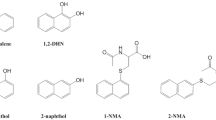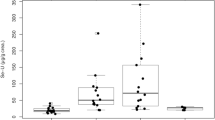Summary
Fifteen workers from a rayon plant in Brazil were monitored. Air samples were taken during a mean period of 5.8 hours out of an 8 hour workshift, in three different adsorbing tubes. Five urine samples were taken at 4 hour interval from the beginning of the shift, and at the beginning of the next shift in which 2-thiothiazolidine-4-carboxylic acid (TTCA) concentration was analysed. Data from seventeen “individuals” were statistically studied, with the aim of establishing the best and the most practical sampling strategy of biological monitoring for workers occupationally exposed to CS2. For those chronically exposed to CS2, TWA air concentration lower than 30 and higher than 10 mg/m3, it was found that the higher the exposure levels, the lower was TTCA concentration in the end of shift urine samples. The results may be explained by dietary habits and/or by the small number of examined population or even eventual casualty. On the other hand they raise other hypothesis involving the chronicity of exposure which may lead to important changes in metabolism influencing the excretion rate of TTCA.
Similar content being viewed by others
References
Campbell L, Jones AH, Wilson HK (1985) Evaluation of occupational exposure to carbon disulphide by blood, exhaled air, and urine analysis. Am J Ind Med 8:143–153
Rosier J, Vanhoome M, Grosjean R, Van De Walle E, Billemont G, Van Peteghem C (1982) Preliminary evaluation of urinary 2 — thio thiazolidine 4 carboxylic acid (TTCA) levels as a test for exposure to carbon disulfide. Int Arch Occup Environ Health 51:159–167
Rosier J, Billemont G, Van Peteghem C, Vanhoome M, Grosjean R, Van De Walle E (1984) Relation between the iodine azide test and the TTCA test for exposure to carbon disulphide. Br J Ind Med 4:412–416
Rosier J, Veulemans H, Masschelein R, Vanhoome M, Van Peteghem C (1987) Experimental human exposure to carbon disulphide. II. Urinary excretion of 2 thiothiazolidine-4-carboxylic acid (TTCA) during and after exposure. Int Arch Occup Environ Health 59:243–250
Van Doom R, Delbressine LPC, Leijdekkers ChM, Vertin PG, Henderson PTh (1981) Identification and determination of 2 thiothiazolidine-4-carboxylic acid in urine of workers exposed to carbon disulphide. Arch Toxicol 47:51–58
Van Doom R, Vanhoome M, Vertin PG (1981) Determination of thio compounds in urine or workers exposed to carbon disulphide. Arch Environ Health 36:289–297
Author information
Authors and Affiliations
Rights and permissions
About this article
Cite this article
Kitamura, S., Ferrari, F., Vides, G. et al. Biological monitoring of workers occupationally exposed to carbon disulphide in a rayon plant in Brazil: Validity of 2-thiothiazolidine-4-carboxylic acid (TTCA) in urine samples taken in different times, during and after the real exposure period. Int. Arch Occup Environ Heath 65 (Suppl 1), S177–S180 (1993). https://doi.org/10.1007/BF00381335
Issue Date:
DOI: https://doi.org/10.1007/BF00381335




